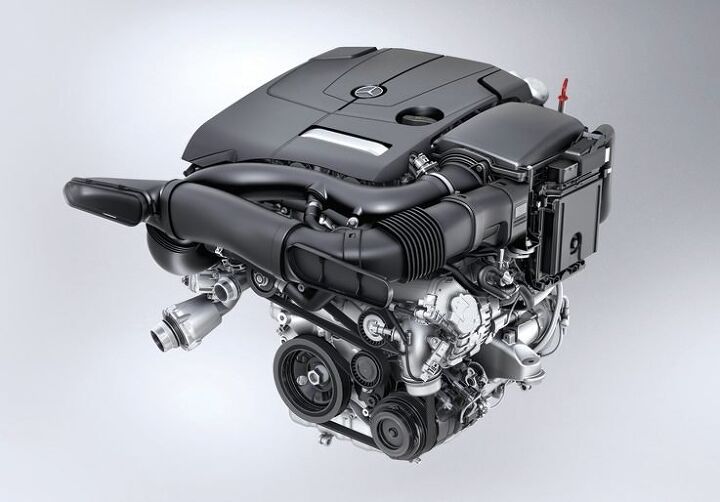Wards 10 Best Engines Doesn't Include a V8 for the First Time in History

For the first time in Wards’ 23 years of testing, its 10 Best Engines list is without a representative from America’s most rootin’-tootin’ of engine configurations.
Last year’s Best Engines list was a grand menagerie of naturally aspirated sixes, forced-induction fours, hybrids, diesels, and a flat-plane V8.
This year’s list is a collection of modestly sized turbo fours and sixes, with a handful of electrification thrown in for good measure.
Perhaps WardsAuto thinks the automotive industry has finally found a formula that works.
In 2015, the 5.2-liter Voodoo V8 found in the Ford Shelby GT350 made the grade due to its impressive engineering and 8,250 rpm redline. This year, Wards didn’t seem to think there was room for anything that didn’t epitomize the perfect marriage of efficiency and performance — a characteristic V8s aren’t particularly well-known for.
“Automakers see downsizing, turbocharging and electrification as key strategies for delivering no-compromise powertrains that also are fuel-efficient, and this year’s list clearly affirms that strategy,” says WardsAuto Senior Content Director Drew Winter.
Ward’s measures the engines as an overall success or failure; marveling solely at tech or being intoxicated by a unit’s performance isn’t enough. Editors score each drivetrain based on power, nose attenuation, fuel economy, new technologies, and comparative specs before deciding if the complete package helps the car shine more brightly than the competition. The only catch is the vehicles tested must have a base price no higher than $62,000 to be eligible.
And the big winners are:
3.0L Turbocharged DOHC I-6 (BMW M240i)
Returning from last years list is the 3.0-liter straight-six from BMW and the dual-motor EREV from the Chevrolet Bolt. Volvo’s turbo and supercharged 2.0 liter also reappears, but as a more-powerful variant. Last year’s Volvo XC90 T6 made 316 horsepower, while this year’s V60 Polestar managed to cram in 362 hp with the help of a fatter turbo, larger intake, and some new camshafts.
The Pacific was praised for its seamless integration of dual electric motors and its the revised 3.6-liter Atkinson-cycle V6, citing it was a game-changing powerplant in terms of both design and implementation.
While the automotive media gushes over the BMW M240i’s I-6 for its smoothness and abundance of torque, Ward’s was careful to point out that it was also more economical than anyone expected. Over 12 days of spirited testing, Ward’s claimed the 3.o-liter B58 in the M240i averaged nearly 26 miles per gallon.
In fact, almost all the chosen motors managed to provide drivers a balance between performance enjoyment and tech-enhanced efficiency. The Focus RS has an engine that’s predictable and linear enough to make for a competent commuter, but also insane enough for track-day mischief. While perhaps atypical as a vehicle, it’s a perfect representation of where the automotive industry is going with smaller engines as technology replaces displacement.
Using fewer raw materials and more science, carmakers are squeezing more from modern engines than ever before. There was a time when asking for 100 hp/liter would have been unfathomable. Now it would be unfathomable to ask for anything less.
With that in mind, ask yourself where that might leave the V8 a few years from now.
[Image: Mercedes-Benz]

A staunch consumer advocate tracking industry trends and regulation. Before joining TTAC, Matt spent a decade working for marketing and research firms based in NYC. Clients included several of the world’s largest automakers, global tire brands, and aftermarket part suppliers. Dissatisfied with the corporate world and resentful of having to wear suits everyday, he pivoted to writing about cars. Since then, that man has become an ardent supporter of the right-to-repair movement, been interviewed on the auto industry by national radio broadcasts, driven more rental cars than anyone ever should, participated in amateur rallying events, and received the requisite minimum training as sanctioned by the SCCA. Handy with a wrench, Matt grew up surrounded by Detroit auto workers and managed to get a pizza delivery job before he was legally eligible. He later found himself driving box trucks through Manhattan, guaranteeing future sympathy for actual truckers. He continues to conduct research pertaining to the automotive sector as an independent contractor and has since moved back to his native Michigan, closer to where the cars are born. A contrarian, Matt claims to prefer understeer — stating that front and all-wheel drive vehicles cater best to his driving style.
More by Matt Posky
Latest Car Reviews
Read moreLatest Product Reviews
Read moreRecent Comments
- Jrhurren Worked in Detroit 18 years, live 20 minutes away. Ren Cen is a gem, but a very terrible design inside. I’m surprised GM stuck it out as long as they did there.
- Carson D I thought that this was going to be a comparison of BFGoodrich's different truck tires.
- Tassos Jong-iL North Korea is saving pokemon cards and amibos to buy GM in 10 years, we hope.
- Formula m Same as Ford, withholding billions in development because they want to rearrange the furniture.
- EV-Guy I would care more about the Detroit downtown core. Who else would possibly be able to occupy this space? GM bought this complex - correct? If they can't fill it, how do they find tenants that can? Is the plan to just tear it down and sell to developers?


































Comments
Join the conversation
Please attenuate this nose.
One more reason I'm never getting rid of my LS430---the 3UZ V8 is sublime, smooth, and refined in no way a V6 will ever be. Lots of torque, too.